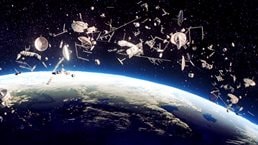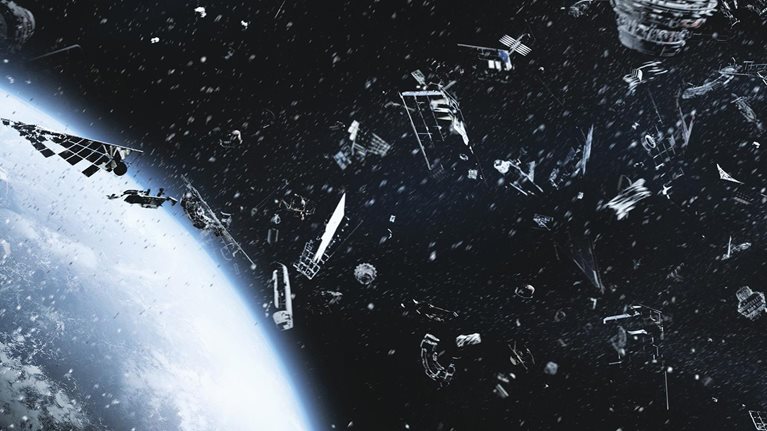
What goes up doesn’t always come down. In 1961, when the Soviet Union sent the first person into space, fewer than 1,000 pieces of junk had accumulated there from previous exploration efforts. Decades later, there are nearly 30,000 pieces—and that number only includes the pieces that are trackable. As space debris accumulates, it poses a growing challenge to space travel and exploration. How did it get up there, and what kind of problems does it present?
Learn more about McKinsey’s Aerospace & Defense Practice.
What kinds of junk are in space?
Formally known as orbital debris, space junk can be bits and pieces of inactive satellites, the rockets that carry them into space, debris from missiles, and detritus left behind by astronauts. Space debris can be as large as a school bus (like the inactive Envisat satellite, launched in 2002) or as small as paint chips. (As we’ll see, just because a piece of space junk is tiny doesn’t mean it’s harmless.) But space junk isn’t all just missile debris and satellite parts. Other objects left behind include the following:
- a spare glove misplaced by astronaut Ed White in 1965
- a spatula lost by astronaut Piers Sellers in 2005
- astronaut Sunita Williams’s camera that drifted away during a 2007 spacewalk
- an Andy Warhol drawing left behind by the Apollo 12 mission in 1969
How does junk get into space?
Junk gets into space the same way junk gets anywhere: people put it or leave it there. Sometimes debris ends up in space because of a rocket launch or because no one bothered to bring down a decommissioned satellite. Other space junk gets there because of an accident. In 1965, two satellites exploded, generating nearly 500 pieces of debris. And 15 years ago, a single collision—the highest-impact collision ever recorded in space—generated more than 3,200 pieces of junk.
Debris is accumulating in space at an alarming rate. Since space exploration began, more than 15,000 satellites have been launched. Now rocket launches take place more than three times per week, many deploying multiple satellites. And every new launch has the potential to generate more junk. In the year 2000, there were around 8,000 trackable pieces of debris in space. By 2019, there were roughly 20,000. Now, just four years later, there are nearly 30,000 pieces of junk larger than a softball floating in space.
The primary contributor to increased space activity and objects in orbit is the growth of satellite constellations. Through 2015, in the 58 years since the first satellite was launched, a total of 7,500 payloads were launched into space. In the eight years since then, the number of total satellites launched has more than doubled. This growth has largely been driven by SpaceX’s Starlink program, which accounts for 50 percent of active satellites in orbit.

Looking for direct answers to other complex questions?
And investments in space exploration are skyrocketing in both public and private sectors. In 2020, investors gave roughly $9 billion to private space entities alone. Predictions abound of even greater investments. At least 70 countries now have space agencies, and many more have increased their space budgets. Based on proposed space projects sponsored by various private and government entities, there may be as many as 12,000 new satellites launched into space per year over the next decade. The burgeoning interest in space exploration has led to a greater focus on ways to help slow the accumulation of space junk. One thing is for sure: unless something is done to curb the accumulation of debris, we can expect a lot more of it. As more countries and private companies invest and engage in space research activity, it’s critical they continue to develop, approve, and comply with policies to support these efforts.
Learn more about McKinsey’s Aerospace & Defense Practice.
Why is space junk potentially dangerous?
Space junk can be dangerous because anything orbiting Earth is moving fast: debris in space travels at roughly 10 kilometers per second. That’s about 300 times faster than the maximum speed on most US highways. And since both objects in a collision would be moving fast, the relative speed would be even higher. A collision with a large object going that fast is obviously dangerous, but even junk as tiny as a paint fleck can be a problem.
Here are some examples of the damage space junk can do:
- A ten-centimeter object—the size of a large bagel—could break an average satellite into pieces upon impact. There are roughly 30,000 similarly sized objects in space (including space junk and naturally occurring debris from comets or asteroids).
- A one-centimeter object—the size of a Cheerio—could puncture the protective shields covering the International Space Station (ISS). In space, there are approximately 670,000 objects larger than a Cheerio.
- A one-millimeter object—the size of a pencil point—could destroy a spacecraft’s ability to power up or to reach a certain altitude upon impact. There are 170 million objects larger than that in space.
These aren’t just hypotheticals. In 2021, the ISS was damaged when a two-inch piece of space junk struck one of its components. Since 2000, the ISS has moved 32 times to avoid coming too close to an object. In 2015, things got even more dramatic: astronauts on the ISS had to evacuate to a space capsule after being warned of junk coming toward them. That incident was a near miss, but as the debris count increases, so does the possibility of future collisions.
While collisions in space are a real danger, the likelihood of space junk reentering Earth’s orbit and doing damage on the ground is relatively low. That’s due to the reaction that occurs when space junk reenters Earth’s atmosphere: the heat and gases created are so intense that junk usually burns up in the process.
How can we prevent further accumulation of space junk?
As both governments and the private sector ramp up space exploration, we can expect more space junk to accumulate. Because of the marked increase we’ve already seen, entities like the United Nations’ Committee on the Peaceful Uses of Outer Space (COPUS) and the European Space Agency (ESA) are already collaborating to establish guidelines for space travel, satellite deorbit, and junk removal. Other governmental efforts include the United States’ Space Policy Directive-3 and Orbital Debris Implementation Plan. Aside from this, other space traffic management efforts are under way from both nongovernmental organizations and companies.
The UN codified recommendations for space activity 50 years ago. But those recommendations don’t address some of the current space challenges. Here’s why:
- The recommendations were made before many of the technological advancements that have led to a massive increase in space activity (and more space junk).
- Countries are not obligated to follow them.
- The guidelines don’t address removing inactive satellites already in space.
How can the space junk problem be addressed? Can space junk be removed from space?
Junk can remain in space for decades, centuries, or even millennia, depending on how close it is to Earth. Space junk in very low Earth orbit (LEO), under around 300 kilometers in altitude, will reenter the atmosphere on its own in a relatively short time. Junk in higher orbits may remain in space indefinitely.
Sustainable space operations should have four components: awareness of the environment, coordination of activities among independent parties, minimizing the growth of space junk, and removal of debris.
-
Increased awareness
Much of the collision risk involved in space operations results from a lack of reliable data that would enable tracking of objects and debris. Improving observation technology and increasing the accuracy of tracking models would make this easier. Enhanced government and commercial tracking systems will contribute to the solution, but better information sharing among satellite operators will also be needed. (That said, tracking doesn’t work in all cases: when space junk is as small as a paint chip, tracking becomes close to impossible.)
-
Better coordination
Best practices for reacting to potential collisions will be increasingly important as space traffic grows. The current system relies on operators manually monitoring an individual satellite’s status and individually reaching out to other operators to plan avoidance maneuvers. With increasing numbers of active satellites, new approaches including automation and established “rights of way” may be necessary.
-
Minimizing debris growth
Minimizing debris growth will be critical to maintaining the space environment. This can be achieved through a combination of regulation, voluntary actions, and international agreements. Regulatory action might include enhanced disposal/deorbit plans as part of licensing. Voluntary actions include both preemptive deorbits of failing satellites and active removal of inactive satellites.
-
Debris mitigation and removal
Most of the debris in space has no way of maneuvering because it is defunct or is the fragment of a larger satellite. For these objects, passive deorbiting—waiting for them to reenter the atmosphere on their own—is currently the only way they can deorbit. The time for an object to passively deorbit can be substantial: for objects in higher orbits, it can take as long as centuries.
Actively deorbiting debris involves collecting debris and moving it to a lower orbit, from which it can deorbit on its own more quickly. Unfortunately, active deorbiting is no small task, whether we’re talking about a large defunct satellite or just a paint chip. Harpoons, magnets, lasers, and even slingshots are being explored as possible ways to capture space junk and bring it down to LEO.
Even more challenging is organizing nations and entities to clean up space. It’s currently unclear who will pay to clean up space. What’s more, objects in space are defined by the Outer Space Treaty, signed by 136 countries including all the major spacefaring nations, to be the sovereign territory of the nation that put them there. Even a benevolent trash collector could not clean up space without the consent of whoever owns the junk.
Learn more about McKinsey’s Aerospace & Defense Practice, and check out aerospace-related job opportunities if you’re interested in working at McKinsey.
Pop quiz
Articles referenced:
- “How will the space economy change the world?,” November 28, 2022, Ryan Brukardt
- “McKinsey for Kids: Space junk—it’s out of this world,” July 13, 2022
- “The role of space in driving sustainability, security, and development on Earth,” May 19, 2022, Ryan Brukardt, Jesse Klempner, Daniel Pacthod, and Brooke Stokes
- “Space around the globe,” April 20, 2022, Ryan Brukardt, Jesse Klempner, Brooke Stokes, and Mary Kate Vaughn
- “Outer space in 2030,” March 29, 2022, Chris Daehnick, Jess Harrington, and Jesse Klempner
- “IoT comes of age," March 7, 2022, Michael Chui and Mark Collins
- “Building a better planet with satellite data,” February 4, 2022, Peter Platzer and Jannick Thomsen
- “Seeing Earth from space: The power of satellite images,” December 13, 2021, Robbie Schingler and Chris Daehnick
- “Look out below: What will happen to the space debris in orbit?,” October 1, 2021, Chris Daehnick and Jess Harrington
- “Wall Street to Mission Control: Can space tourism pay off?,” May 12, 2021, Chris Daehnick and Jess Harrington



